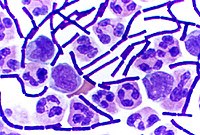This article needs additional citations for verification. (March 2018) |

A counterstain is a stain with colour contrasting to the principal stain, making the stained structure easily visible using a microscope.
Examples include the malachite green counterstain to the fuchsine stain in the Gimenez staining technique and the eosin counterstain to haematoxylin in the H&E stain.[1] In Gram staining, crystal violet stains only Gram-positive bacteria, and safranin counterstain is applied which stains all cells, allowing the identification of Gram-negative bacteria as well. An alternative method uses dilute carbofluozide. Counterstains are sometimes used to separate animals from organic detritus in microbiology studies.
- ^ Williams, D.; Williams, N. (22 December 2003). "A counterstaining technique for use in sorting benthic sample". Limnology and Oceanography. 19 (1): 152–154. doi:10.4319/lo.1974.19.1.0152.